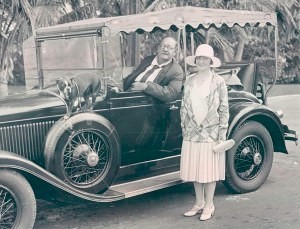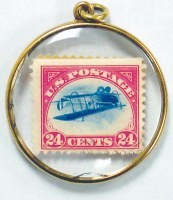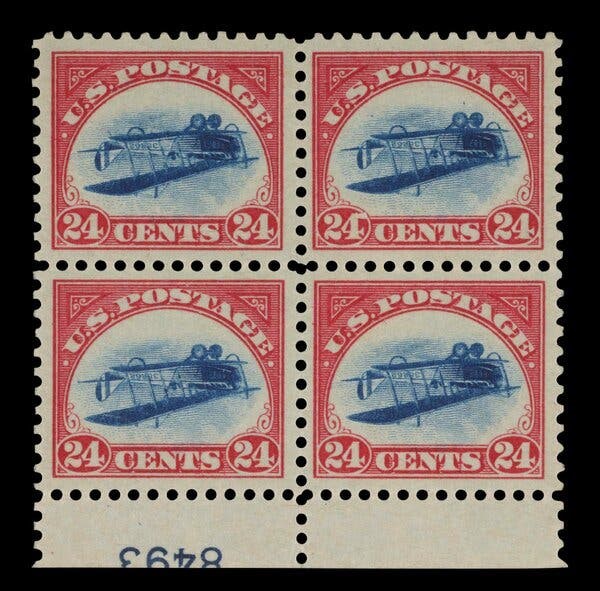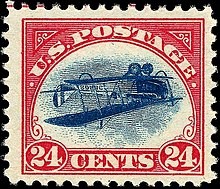Hello all you stamp friends out there. I this blog I will bring you all the exiting stamp stories from around the world. Today I will tell you the exciting story of the “Inverted Jenny”, one of the most rare and expensive stamps of the world. In 2018 a single copy of the inverted Jenny was sold for no less than 1.593.000 $. My name is Vagn Juhl-Larsen. I am from Denmark and have been a stamp collector for more than 50 years.
First a little bit of Pre-history
Before and during the first world war, mail was transported by ship, train or car. In 1917 the first airmail stamp in the world was issued in Italy. It was used for the transportation of letters by air between Rome and Torino

Fig 1:The first air mail stamp of the world. A lot of countries soon followed the example of Italy.
On the 10th of May 1918 a special 24 cent air mail stamp was issued by the United States Post Office. It was to be used to send mail between Washington D. C., Philadelphia and New York City, a regular service that was introduced on the 15th of May 1918. The stamp was called “The Jenny”, because that was the nickname of the plane in the middle.

Fig. 2. The Jenny in the center of the first US airmail stamp.
Design and production
And now to the design and production of the “Jenny” stampThe design and production of the new air mail stamp was put in the hands of the “Bureau of Engraving and Printing” (BEP). This organization was established in 1862 and produced most US stamps until the 1960ties. After that private companies printed still more of the US stamps and the BEP stopped printing US stamps altogether in 2005.The stamp was designed by chief designer Clair Aubray Hudson, who lived from 1885 to 1938.

Fig. 3: Clair Aubray Hudson (1885-1938) was the designer of “The Jenny”.
As you can see from the picture of the stamp, it was a very beautiful stamp in the national colors of the United States: a red frame with a blue center showing an airplane. In the upper part of the frame is the words: US POSTAGE, and below the denomination: 24 cents. A rather controversial price compared to the 3 cents, that was the normal rate for a first class letter at that time. The airplane in the center of the stamp is a so called Curtiss JN-4 with the number: 38262. Because of the letters JN the aircraft soon got the nickname: “The Jenny”. The plane was build in no less than 6.800 copies from 1915 and onwards during the first world war. It was used as a training aircraft by the US air force and after the war a large number was sold to private persons and companies.The United States Post Office bought a modified version of the Jenny. The original aircraft was a to seater. Six of the original planes were modified to transport mail by removing the second seat. On May 15th 1918 at exactly 11.47 AM Jenny number 38262 departed from Washington D. C. heading for Philadelphia and New York. The airmail era in the United States of America had begun.

Fig. 4: Jenny number 38262 departed from Washington D. C. at exactly 11.47 AM on May 15th 1918.
The story of “The inverted Jenny”
As you can see from the picture below, the air mail stamp was printed in sheets of 100 copies. It was then perforated except for the upper and right side. That resulted in nine stamps without perforation on the upper side. One stamp was not perforated on both the upper and the right side and nine stamps not perforated on the right side. Because the stamp had to colors – printing was performed in a two step process. First the frame was printed and then the center. During that process a single sheet was printed with an inverted center. The “Inverted Jenny” was born.

Fig. 6: A whole sheet of “The inverted Jenny”
And now to the story about how the inverted Jenny was discovered The new air mail stamp was distributed to the post offices in Washington D. C., Philadelphia and New York on Monday May 13th 1918.

Fig. 7: William T. Robey who found the “Inverted Jenny

Fig. 8: Post Office on New York Avenue in Washington D.C. where “The Inverted Jenny” was found
On Thuesday, May 14th a stamp collector, William T. Robey, who lived from 1889 to 1949, went to his local Post Office on New York Avenue in Washington D.C. to buy the new air mail stamp. He actually went to the post office with the intension of finding a sheet of stamps with an inverted center. He did so because he was aware of a former example of an inverted center from stamps issued in 1901. He went early in the morning, but because he was not satisfied with the centering of the stamps he was offered, he left again and returned at around noon. At that time new supplies of the stamp had arrived and he immediately saw, that the first sheet, he was offered by the clerk had an inverted center. William T. Robey later told that his heart stopped, when he first saw the inverted Jenny. But his fortune was made. Let us now look at, what happened to the sheet of the “Inverted Jenny”
In the afternoon two inspectors from US mail tried to confiscate the sheet from William T. Robey, but in vain. In the days after he bought the sheet of the “Inverted Jenny”, he contacted a number of stamp dealers. He was first offered 500 $, but during the next days the price increased dramatically, and Robey ended up selling the sheet for 15.000 $ to rare stamp dealer Eugene Klein on the 20th of May 1918. Thereby William T. Robey changed his investment of 24 $ to a sum worth around 300.000 $ in todays money.

Fig. 9: Rare Stamp dealer Eugene Klein
Eugene Klein imediately sold the sheet to the millionaire Edward H. R. Green, who lived from 1868 until 1936 for 20.000 $, and thereby got a profit of 5.000 $. But before he did so, he marked the backside of every stamp with a number from 1 to 100. In that way it was later possible to determine the position of the individual stamp in the sheet. On the other hand the pencil marks on the backside meant, that none of 100 inverted Jennys are total pristine.

Fig 10: Eugene Klein marked each ”Inverted Jenny” with a pencil before he sold them the millionaire Edward H. R. Green. Here number 49 in the sheet.

Fig. 11: Colonel Edward H. R. Green with his wife, Mabel.

Fig. 12: The locket that Colonel Green gave as a present to his wife Mabel
Klein advised Green to split up the sheet and sell the stamps individually and in blocks. Green kept 41 copies for himself. Among them an 8 copy plate number block from the lower part of the sheet. A copy was placed in a locket, that was given to his wife Mabel as a present. The rest of the stamps were sold individually for prices between 250 and 325 $ for perforated copies and a little less for copies with straight edges, around 175 $. After the death of colonel Green most of his inverted Jennies were sold at auctions in the 1940ties. For example the plate number block of 8 was sold for 27.000 $ in 1944 to the collector Amos Eno who removed 4 of the stamps. After the death of Amos Eno the now plate number block of 4 was sold for 150.000 $ in 1971. In 2005 this same block was sold for no less than 2.970.000 $ and believe it or not, the block was sold again in 2021 by the famous auction house Sotherbys for no less than 4.900.000 $. A record sum for an American stamp.

Fig. 13: Plateblock of four sold for 4.9 million $ in 2021.
Many of the “Inverted Jennies” have been sold by the famous stamp auction firm Siegel auction Galleries. If you want to learn more exciting details about “The inverted Jenny”, it is very rewarding to visit their homepage: invertedjenny.com. Here they actually keep track of the 100 stamps and when they were last sold. The only stamp that remains missing in 2022 is position 66. That was the story of the inverted jenny, but there is actually an afterstory.
Afterstory
In September 2013, the year of 95th Aniversary of the “inverted Jenny” the United States Postal service issued a souvenir sheet with 6 copies of the famous stamp. The only difference was the denomination that was changed from 24 cents to 2 $. In addition to the regular souvenir sheets, 100 sheets with “non-inverted Jennies” were produced and send randomly to post offices around the United States. In June 2014 a copy of this sheet was sold by Siegel Auction Galleries for 51.750$.

Fig. 14: A souvenir sheet with the “Inverted Jenny” was issued in September 2018.
References
https://www.history.com/news/10-most-valuable-stamps-in-american-history
https://en.wikipedia.org/wiki/Inverted_Jenny
https://invertedjenny.com/
https://postalmuseum.si.edu/topics/inverted-jenny
https://www.mysticstamp.com/Products/United-States/C3a/USA/
The end
That was all for this week, but don’t forget to join us for next weeks story. Here we present the exciting story of the unique “Tre skilling yellow” from Sweden – one of the most rare and expensive stamps of the world. In 2010 the “Tre skilling Yellow” was sold for 2.3 million $.

Fig. 15: British Guiana one cent magenta. The most expensive single stamp ever sold.
Please register as a subscriber of Stampstars.com



